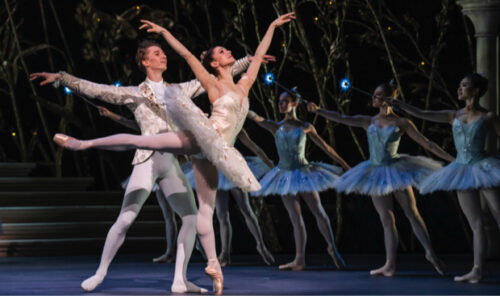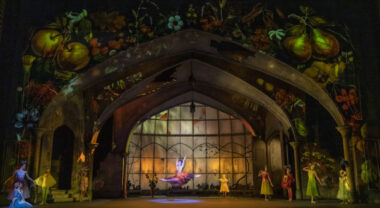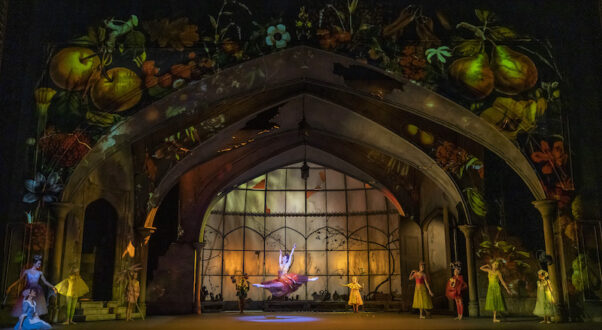 United Kingdom Prokofiev, Cinderella: Dancers of The Royal Ballet, Orchestra of the Royal Opera House / Koen Kessels (conductor). Broadcast (directed by Ross MacGibbon) from the Royal Opera House, Covent Garden, London, to Cineworld Basildon, Essex, 12.4.2023. (JPr)
United Kingdom Prokofiev, Cinderella: Dancers of The Royal Ballet, Orchestra of the Royal Opera House / Koen Kessels (conductor). Broadcast (directed by Ross MacGibbon) from the Royal Opera House, Covent Garden, London, to Cineworld Basildon, Essex, 12.4.2023. (JPr)

Production:
Choreography – Sir Frederick Ashton
Set designer – Tom Pye
Costume designer – Alexandra Byrne
Lighting designer – David Finn
Video designer – Finn Ross
Illusions – Chris Fisher
Staging – Wendy Ellis Somes, Gary Avis
Cast (included):
Cinderella – Marianela Núñez
The Prince – Vadim Muntagirov
Cinderella’s Stepsisters – Luca Acri, Gary Avis
Cinderella’s Father – Bennet Gartside
The Fairy Godmother – Fumi Kaneko
The Fairy Spring – Anna Rose O’Sullivan
The Fairy Summer – Melissa Hamilton
The Fairy Autumn – Yuhui Choe
The Fairy Winter – Mayara Magri
The Jester – Taisuke Nakao
As Petroc Trelawny – who introduced the broadcast alongside Dame Darcey Bussell – reminded those watching in a very full Cineworld Basildon, Cinderella was Sir Frederick Ashton’s first major three-act ballet for a British company, explaining how the choreography he created in 1948 ‘was a nod to the classic traditions of the past but emerging in his own distinctive style combining grand pas de deuxs and intricate corps de ballet work with elements of popular British stage tradition, like the characters of the stepsisters.’ Later, I learnt for the first time from Trelawny how Ashton ‘originally had the idea that women would dance the stepsisters’ but, of course, it was Ashton and Robert Helpmann who created those parts. Interestingly we were told by Kevin O’Hare, director of The Royal Ballet, how in certain performances of a long run Kirsten McNally and Christina Arestis were indeed performing as the stepsisters. As this wasn’t one of them, from that moment I became biased against the two ‘grotesques’ we were presented with.
When I first saw Ashton’s Cinderella at Covent Garden in 1975 it was Helpmann and Ashton I saw as the stepsisters! Back then their interaction and jealousies seemed less music hall and more natural, and even the very odd moment in the second act involving oranges of differing sizes did too. By underplaying the roles, they showed how less can mean more, something not understood by Gary Avis and Luca Acri, clearly two men in drag (especially in their Act III vests) with Acri underperforming and Avis blatantly channelling the late Paul O’Grady’s Lily Savage.
We were told how Wendy Ellis Somes – widow of Michael Somes, Ashton’s first prince – has a ‘passion for the Ashton legacy’ and has overseen this recent restaging (alongside Gary Avis). Alexandra Byrne speaking about her costumes revealed how ‘Wendy was very clear she didn’t want it to be a particular period so … the purveyors are a kind of mix of eighteenth-century dandies, rockabilly teddy boy … I was thinking about the sisters, and I like the idea of them becoming fashion victims, consumer victims, so it’s all about their appearance, so they become the kind of hothouse, cultured flowers, whereas the seasons and Cinderella are very much to do with meadow and wildflowers.’ We had heard from set designer Tom Pye how ‘The theme of nature was the constant thread in all three acts, so [in Act I] these meadow flowers, glided flowers, may hold the space and hold the dance and make a really nice frame. In Act II, rather than that being inside a classic, sometime clichéd, ballroom we took it outside and did it as a garden party.’

Pye’s designs are completed by the vaulted home for Cinderella’s family with a stage-wide mullion window at the back. (Dame Darcey Bussell descriptively said how, ‘The walls begin to crack as spring turns to summer and autumn gives way to winter.’) For the final act Cinderella and her prince begin to ascend a long flight of stairs fading into the distance of their ‘happy ever after’. There are nature-inspired embellishments on nearly all the costumes, whether pastel-shaded or garish, and video imagery (from Finn Ross) enhancing Pye’s theme, though this didn’t come over too well on screen. Chris Fisher was credited with ‘illusions’ which for me meant something magical happening. If it did I must have missed it, I would have thought a way could have been conjured up (!) to allow the ‘mysterious woman’ of the first act – to be transformed directly into the Fairy Godmother without the ‘in disguise’ Olga Sabadoch switching with Fumi Kaneko. Also, the resplendent coach drawn by four ‘mice’ simply just turns up.
All in all, what The Royal Ballet presents is Ashton’s museum piece brought out of its glass case after a decade for its 75th anniversary and given a Disneyfied ‘Cinderella-The Musical’ makeover. According to Wendy Ellis Somes, ‘One of the most important things that Fred ever said to me was tell the story, being musical and use your épaulement and port de bras.’ Constant upper body and arm movement is a characteristic of Ashton’s choreography, unfortunately, principal dancers shown rehearsing – under Ellis Somes’s stern gaze – were simply instructed to recreate the steps without being allowed any real opportunity, it seemed, to interpret the steps and make them their own.
Overall, the ensemble dancing was meticulous and in keeping with the small-scale Petipa-inspired choreography. I liked Fumi Kaneko’s serene Fairy Godmother solo; Anna Rose O’Sullivan in yellow and green was a suitably effervescent and fleet-footed Spring Fairy and Yuhui Choe mimicked the fiery colours she was wearing through the attack of her steps as Autumn. David Donnelly caught the eye as the Dancing Master, Lukas B. Brændsrød and Philip Mosley were suitably amusing as the Act II ‘suitors’ (one as Wellington and the other Napoleon, whose wig mishap was a real ‘laugh out loud’ moment) and the four prince’s friends (Joseph Sissens, Nicol Edmonds, Benjamin Ella, and Calvin Richardson) effectively partnered the four fairies. The only real virtuoso male role is that of the Jester and the high-spirited Taisuke Nakao, had all the charisma of Wayne Sleep who made a name for himself in the role, and who I saw in 1975 and again in 1981. The kaleidoscopically costumed Jester never ceases his mercurial movement, repetitively leaping and spinning around the stage.
In some pre-recorded remarks about his role Vadim Muntagirov admitted that there was ‘not much drama happening, just being a prince and try to find your love’. So, with little or nothing to do Muntagirov’s Prince looked regal and handsome enough and his long-limbed dancing was crisp and secure and his partnering tender and caring, but – as so often with Muntagirov – there was no real ‘wow’ factor in his solo and he exuded disappointingly little personality. Marianela Nuñez – having recently celebrated her 25th anniversary with the company – was an engaging Cinderella who elicited our sympathy by the fireplace cradling her broom imaging it was the prince asking her to dance. For Nuñez she most liked Cinderella’s ‘pure soul [as] good things happen to good people, so she ends up being the princess that she always wanted to be’. In fact, it was in the radiance and poise (particularly, the entry en pointe down the steps) needed in the second act that Nuñez excelled, her dancing as dependable and precise as ever.
Prokofiev’s Cinderella was composed during the Second World War, and it is not a surprise that those troubled times seem reflected in a score – at least here from Koen Kessels and the impeccable Orchestra of the Royal Opera House – that was surprisingly more bittersweet and angst-ridden than romantic. Completed nearly ten years after Romeo and Juliet in 1944 – and only four years before Ashton choreographed his Cinderella – now in 2023 it is time for alternate choreography and a revised mise-en-scène.
Jim Pritchard

Spot on, Jim. Wendy E S was a so-so dancer who shouldn’t have been let within miles of any Ashton stagings. Oh, if only Sir Fred had left a proper will. [edited]